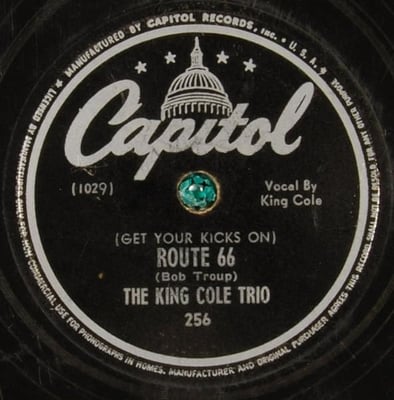Nat King Cole
Lyrics
[Verse 1]
If you ever plan to motor west
Travel my way, take the highway that's the best
Get your kicks on Route 66
[Verse 2]
It winds from Chicago to L.A
More than two thousand miles all the way
Get your kicks on Route 66
[Bridge]
Now you go through St. Louis
Joplin, Missouri
And Oklahoma City looks mighty pretty
You'll see Amarillo
Gallup, New Mexico
Flagstaff, Arizona
Don't forget Winona
Kingman, Barstow, San Bernardino
[Verse 3]
Won't you get hip to this timely tip?
When you make that California trip
Get your kicks on Route 66
[Guitar and Piano Solos]
[Verse 3]
Won't you get hip to this timely tip?
When you make that California trip
Get your kicks on Route 66
Get your kicks on Route 66
Get your kicks on Route

When it comes to classic American songs, "(Get Your Kicks On) Route 66" ranks high on the list. The song's iconic melody and lyrics evoke images of a bygone era where the promise of adventure and the open road beckoned. Written in 1946 by Bobby Troup, the song has been covered by numerous artists, but it was the Nat King Cole Trio that recorded and released the first version that became a hit that year.
About (Get Your Kicks On) Route 66
As the title suggests, the song is an homage to Route 66, one of the most famous highways in America. Stretching over two thousand miles, from Chicago to Los Angeles, it was a primary westward route before the advent of interstate highways. The lyrics namecheck various stops along the way, where travelers could find "Whiskey bars" and "motels," but it's the sense of freedom and possibility that really makes the song resonate with listeners.
One reason for the song's lasting popularity is the timeless quality of the music. The Nat King Cole Trio's version features a walking bassline, jaunty piano, and Cole's smooth, mellifluous voice. It's a perfect match for Troup's lyrics, which capture the spirit of the road and the American dream. The song proved to be a hit, making the pop and R&B charts, and it quickly became a standard with many cover versions recorded over the years.
One of the unique aspects of Route 66 is that it allowed drivers to experience much of the American West, from the plains of Oklahoma to the deserts of Arizona. Troup's lyrics reflect this by listing all the towns and cities in between. As such, the song became something of an anthem for the open road. Generations of Americans, from the Beatniks of the 1950s to the Baby Boomers of the 1960s, heard the song as a call to adventure, and perhaps a representation of the spirit of American freedom.
Cole himself recorded two additional versions of "Route 66." In 1956, he performed a new arrangement that was released on his "After Midnight" album. In this version, he pronounces the famous highway as "Route six six" as opposed to "Route sixty-six" in the original. This change was likely due to the song's popularity with younger audiences, who may have preferred the more casual pronunciation.
In 1961, Cole re-recorded the 1946 arrangement in the then-new stereo format, which appeared on "The Nat King Cole Story." The new recording is arguably crisper than the original, with Cole's voice standing out more prominently against the instrumentation. But both versions are equally beloved, and it's interesting to see how Cole's interpretation of the song changed over time.
Although "Route 66" was written over 70 years ago, the song's message of adventure and freedom still resonates with modern audiences. The image of the open road, stretching out ahead, is a powerful one, and the song captures it perfectly. For those who want to experience a piece of American history, the song "Route 66" remains an essential listen, and it continues to inspire generations of musicians to this day.
- Release Date: April 22, 1946
- Artist: Nat King Cole

